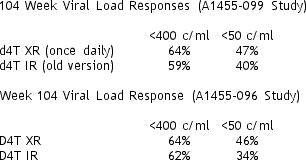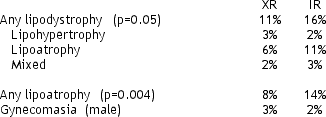 |
 |
 |
| |
|
D4T Once Daily 2-Year Follow-up: lipoatrophy and peripheral neuropathy, and antiviral activity
|
| |
| |
Two-Year Analysis of Stavudine Extended-Release/Prolonged Release Capsules (XR/PRC) as Compared to Stavudine Immediate-Release (IR): Efficacy and Safety
Reported by Jules Levin
Reported at 43rd Annual Interscience Conference on Antimicrobial Agents and Chemotherapy, Sept 14-17, 2003, Chicago
H Brett-Smith, L Reynolds, L Bessen, V Rutkiewicz Pharmaceutical Research Institute, Bristol-Myers Squibb Company, Wallingford, CT, USA
Brief summary of this absrtact: Bristol-Myers researchers reported a comparison of safety from 2 studies (n=900) of d4T once daily (extended release) vs d4T old version twice daily. Data from the 2 studies were pooled. Patients in the studies received d4T, the old or new version, plus 3TC and efavirenz (Sustiva). The average time on treatment was 115 weeks. Regarding antiviral efficacy from these two studies the two versions of d4T appear comparable (see results below). Peripheral neuropathy and lipoatrophy have been associated with d4T use and in this analysis was found to occur at lower rates when the new version once daily d4T was used compared to the old version twice daily d4T. Events of peripheral neuropathy occured at lower rates on d4T once daily (XR/PRC), and this trend had significance for grade 2-4 events that are judged by the investigator to be related to study therapy (4% vs 8%, p=0.005). There were significantly fewer events of any lipoatrophy for patients taking d4T once daily (XR/PRC) treatment group (8% vs 14%, p=0.004). Lactate lab abnormalities and pancreatitis events were comparable in the 2 treatment groups. Although the new once daily version of d4T is approved by the FDA, it is not available in the pharmacy now due to manufacturing limitations. But availability is expected in the future.
This article provides excerpts from poster H-843 presented at the ICAAC meeting which reports improvements in adverse events for d4T once daily (extended release) compared to the older version of d4T taken twice daily.
Stavudine (d4T) XR/PRC provides equivalent 24 hour exposure to d4T IR, but has 1/2 the peak and 2-3 fold higher trough plasma levels. Week (wk) 48 efficacy and safety data demonstrated comparability, but the differing pharmacokinetics could result in clinically relevant differences in outcomes with longer dosing.
This analysis integrates results from two randomized, double-blind (through 1 year), studies of treatment-naive patients comparing XR/PRC versus IR, each with lamivudine (3TC) and efavirenz (EFV). At 1 year, subjects could elect to rollover into a common long-term dosing study. Efficacy is not censored for successful 1 year completers who did not rollover. Safety data are cumulative from start of therapy through on-going dosing as of March 2003.
Median baseline values: HIV RNA 4.8 log10 c/mL and CD4 277 cells/mm 3 . Median time on treatment: 115 wks. The most common regimen-related adverse events (AE) were dizziness, peripheral neurologic symptoms (PNS) and rash. PNS includes numbness, paresthesias, or pain in distal extremities.
The authors conclude that overall two-year efficacy and safety for Stavudine XR/PRC are comparable to IR, with trends which favor XR for safety events of interest.
Background
Stavudine XR/PRC (extended release/prolonged release capsules) was designed to enhance convenience to patients with once daily dosing while providing an overall drug exposure comparable to that of conventional stavudine IR (immediate release). The continuous release of drug throughout the gastrointestinal tract results in lower peak levels (approximately 1/2 that of IR) and higher trough levels (2-3 times higher than IR).
Week 48 efficacy and safety data from two clinical trials have demonstrated non-inferior efficacy and comparable safety between the two stavudine formulations. Both the efficacy and safety of Nucleoside Reverse Transcriptase Inhibitors (NRTIs) are believed to be mediated through the PK of the active triphosphate form. There are limited data available regarding intracellular stavudine triphosphate dynamics in samples from patients under treatment with stavudine. These limited data are consistent with previous in vitro information suggesting that stavudine enters and leaves cells rapidly by non-facilitated diffusion.iii Although the intracellular PK relationships between XR/PRC and IR remain to be explored, it is expected that the lower plasma peak and higher plasma trough of XR/PRC will persist qualitatively in clinical samples. Thus, differing pharmacokinetics (PK) could result in clinically relevant differences in outcomes with longer dosing. One safety parameter of particular importance is peripheral neuropathy, since it is the only dose-related clinical toxicity iv that has been identified. This analysis provides two-year efficacy follow-up for both trials and long-term (maximum duration 178 weeks) integrated safety follow-up.
STUDY DESIGN
Studies 096 and 099 were multinational, randomized, double-blind, placebo-controlled studies in treatment naïve HIV-infected. Study 096, initiated October 1999, was powered for non-inferiority of XR/PRC versus IR with respect to the change in HIV RNA from baseline through 48 weeks; treated subjects totaled 150 (74 XR/PRC; 76 IR). Study 099 was initiated in July 2000 and was powered for non-inferiority of XR/PRC versus IR with a total of 784 treated subjects (392 XR/PRC; 392 IR). The primary endpoint was the proportion of subjects having an HIV RNA below 400 c/mL at 48 weeks.
After the completion of these one-year studies, patients from both were eligible to roll over onto a long-term, follow-up protocol (study 110) which remains on-going. On 110, subjects continue open-label dosing with their original XR/PRC versus IR formulation of stavudine. Both study cohorts enrolled antiretroviral-naive subjects, either with HIV RNA >5000 c/mL (study 096) or > 2000 c/mL (study 099), and having a CD4 count >100 cells/µL(c/µL) without acute opportunistic infections at enrollment.
SAFETY ANALYSES:
Safety data from studies 096, 099 and 110 were integrated into a single, cumulative database. All on-study data are presented for the pooled population.
Peripheral Neuropathy (Peripheral Neurologic Symptoms or PNS) was prospectively assessed at each study visit with both a targeted physical exam and symptom review.
Among spontaneously reported adverse events, the following were considered of specific interest: pancreatitis, symptomatic hyperlactatemia (SHL) or lactic acidosis syndrome (LAS).
Criteria for 'lipodystrophy' were not prospectively defined in the protocols, and these events were not objectively confirmed. Events reported under this term were queried and the Investigator was asked to classify the event as 'lipohypertrophy', 'lipoatrophy' or both. The term 'lipohypertrophy' includes reports of increased abdominal girth, buffalo hump, and breast enlargement in women. The term 'lipoatrophy' includes events of facial, extremity, or subcutaneous fat loss or wasting. Reports of 'gynecomastia' refer specifically to breast enlargement in males.
Baseline Characteristics
The two treatment arms appear comparable. Median viral load was 4.78 log in both d4T arms. 38% in both groups had >100,000 copies/ml. Median CD4 count was 280 in both groups. 28% in both groups had <200 CD4 counts.
ITT Efficacy Response
Treatments received in the studies: d4T (XR or IR) +3TC+efavirenz
Patients received d4T XR or d4T IR, dosing is based by weight. Patients 60 kg or more received 100 mg of d4T XR once daily or d4T 75 mg if they weighed <60 kg. If patients received older version of d4T IR, they received 40 mg or 30 mg based on patient weight. The studies were placebo controlled and randomized.
All patients received 3TC 150 mg BID + EFV 600 mg QD EFV NFV allowed in cases of EFV intolerance
Intention To Treat - ITT: The primary analyses presented here use the denominator of all-treated subjects and provide a cross-sectional assessment of HIV RNA values at a single timepoint (i.e., the specified analysis week). In these ITT analyses, non-completers are considered to be failures (NC=F). With respect to the 110 experience, these analyses are not censored for successful 1 year completers who did not rollover onto the long-term study. Pooled results are provided in the abstract above; results by study cohorts (096/110 and 099/110) are provided in the results section.
|
|
| |
| |
 |
|
| |
| |
Subject Discontinuation
12% in the XR group discontinued prior to week 48 vs 16% in the IR group. 7% in the XR group discontinued due to adverse event in the XR group vs 9% in the IR group.
Safety
Overall Safety: The most common adverse events related to study regimen and of moderate to severe intensity (Grades 2-4) were comparable between the two treatment groups. There have been a total of 9 deaths on this study, 5 on XR/PRC and 4 on IR.
Moderate to severe treatment related adverse events grade 2-4 were comparable in 2 treatment groups for these AEs: dizziness, rash, headache, abnormal dreams, diarrhea, nausea.
PNS was 4% in XR group vs 8% in IT group. Fatigue was 3% in XR group vs <1% in IR group.
Grade 3-4 lab abnormalities comparable: neutrophils, AST, ALT, lipase. Fasting triglycerides were 5% in XR group vs 8% in IR group.
Peripheral Neuropathy
PNS includes numbness, paresthesias, or pain in distal extremeties
|
|
| |
| |
 |
|
| |
| |
LIPODYSTROPHY
Reports of body changes were based on doctor observation, not objective testing.
|
|
| |
| |
 |
|
| |
| |
--Lipohypertrophy includes reports of increased abdominal girth, buffalo hump, and breast enlargement.
--Lipoatrophy includes events of facial, extremity, or subcutaneous fat loss or wasting.
--Gynecomasia refers specifically to breast enlargement in males.
SHL, LAS and pancreatitis (lactate related events) were comparable in XR and IR groups:
|
|
| |
| |
 |
|
| |
| |
For cases of SHL/LAS, the median time to presentation of symptoms was 44 weeks (range 34 - 57 weeks). No additional events have been reported through the datalock for this analysis, suggesting that in naive patients there may be a window of highest risk for this event between 9-14 months after initiating treatment with antiretrovirals. |
|
| |
|
 |
 |
|
|